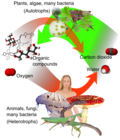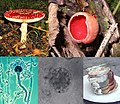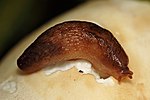A heterotroph (/ˈhɛtərəˌtroʊf, -ˌtrɒf/; from Ancient Greek ἕτερος (héteros) 'other' and τροφή (trophḗ) 'nutrition') is an organism that cannot produce...
28 KB (2,963 words) - 13:47, 23 August 2024
Myco-heterotrophy (redirect from Myco-heterotrophs)
food from parasitism upon fungi rather than from photosynthesis. A myco-heterotroph is the parasitic plant partner in this relationship. Myco-heterotrophy...
17 KB (1,617 words) - 08:43, 23 August 2024
Phototroph (redirect from Phototrophic heterotroph)
energy currency for the cell. Phototrophs can be either autotrophs or heterotrophs. If their electron and hydrogen donors are inorganic compounds (e.g....
8 KB (740 words) - 06:42, 16 August 2024
Carbon source (biology) (section Heterotrophs)
organism to synthesise biomass. Such sources may be organic or inorganic. Heterotrophs must use organic molecules as a source of both carbon and energy. In...
2 KB (481 words) - 09:12, 5 January 2024
Chemotroph (redirect from Chemotrophic heterotroph)
as a synonym of chemoautotrophy. Chemoheterotrophs (or chemotrophic heterotrophs) are unable to fix carbon to form their own organic compounds. Chemoheterotrophs...
9 KB (820 words) - 08:24, 24 September 2024
that transfer energy in the anabolic processes of ATP synthesis (in heterotrophs) or biosynthesis (in autotrophs). The electron or hydrogen donors are...
19 KB (1,636 words) - 13:31, 17 June 2024
on 28 February 2018. Retrieved 25 February 2018. Bergman, Jennifer. "Heterotrophs". Archived from the original on 29 August 2007. Retrieved 30 September...
127 KB (11,413 words) - 18:26, 15 October 2024
Geosiris aphylla is sometimes called the earth-iris. It is a small myco-heterotroph lacking chlorophyll and obtaining its nutrients from fungi in the soil...
2 KB (185 words) - 18:30, 14 September 2023
and will be used as carbon and energy source by other organisms (e.g. heterotrophs and mixotrophs). The photoautotrophs are the main primary producers,...
19 KB (2,041 words) - 18:07, 1 October 2024
have formed a network of trophic relationships between autotrophs and heterotrophs, which are included in the stages of Lepidoptera larvae, pupae, and adults...
155 KB (16,840 words) - 22:01, 16 October 2024
cyanobacteria gather energy directly from sunlight by photosynthesis. Heterotrophs including all animals, all fungi, all completely parasitic plants, and...
138 KB (14,771 words) - 06:04, 1 October 2024
some protists is chitin in their cell walls. Fungi, like animals, are heterotrophs; they acquire their food by absorbing dissolved molecules, typically...
200 KB (19,174 words) - 03:56, 29 September 2024
such as Armillaria, and saprotrophs. These orchids are known as myco-heterotrophs, but were formerly (incorrectly) described as saprophytes as it was believed...
60 KB (6,350 words) - 23:32, 16 October 2024
and symbiotic associations between chemosynthesizers and respiring heterotrophs are quite common. Large populations of animals can be supported by chemosynthetic...
12 KB (1,202 words) - 13:46, 26 June 2024
which are vital for other species within the ecosystem. Ecology portal Heterotroph Lithotroph Ecological pyramid Predator-prey interaction "The Food Chain"...
18 KB (2,034 words) - 20:50, 15 October 2024
dioxide through anaplerotic fixation. The flavobacterium is still a heterotroph as it needs reduced carbon compounds to live and cannot subsist on only...
20 KB (2,148 words) - 20:22, 7 September 2024
unites tortoises, snails and sponges. Being animals, invertebrates are heterotrophs, and require sustenance in the form of the consumption of other organisms...
45 KB (5,000 words) - 08:01, 8 September 2024
level are the heterotrophs, which are the species that obtain energy by breaking apart organic compounds from other organisms. Heterotrophs that consume...
133 KB (13,837 words) - 12:48, 11 October 2024
independently evolved various levels of endothermy. Bony fish can be any type of heterotroph: numerous species of omnivore, carnivore, herbivore, filter-feeder, detritivore...
32 KB (2,199 words) - 14:38, 15 October 2024
including the species Chilomonas paramecium. Chilomonas is a protozoan (heterotroph). Chilomonas is golden brown and has two flagella. Guiry, M.D.; Guiry...
2 KB (88 words) - 19:18, 25 May 2024
Monotropastrum humile, a myco-heterotroph dependent on fungi throughout its lifetime...
32 KB (3,726 words) - 20:08, 13 October 2024
level, is used in ecology to broadly classify organisms as autotrophs or heterotrophs. This is a non-binary classification; some organisms (such as carnivorous...
82 KB (8,609 words) - 02:25, 7 October 2024
of thiobacilli and other sulphur-oxidizing autotrophs, mixotrophs and heterotrophs". Philosophical Transactions of the Royal Society of London. Series B...
99 KB (11,069 words) - 03:21, 28 September 2024
compounds such as nitrate, sulfate, or carbon dioxide. Many bacteria, called heterotrophs, derive their carbon from other organic carbon. Others, such as cyanobacteria...
143 KB (15,532 words) - 00:56, 20 September 2024
golden algae, euglenids, dinoflagellates, and other algae have become heterotrophs (also called colorless or apochlorotic algae), sometimes parasitic, relying...
92 KB (10,551 words) - 20:43, 30 September 2024
and can make use of a variety of different resources (for example, a heterotroph with a varied diet). A specialist species can thrive only in a narrow...
7 KB (848 words) - 04:39, 19 June 2024
chemosynthesis. Heterotrophs are organisms that must feed on others for nourishment and energy (respiration exceeds production). Heterotrophs can be further...
210 KB (21,521 words) - 06:09, 3 September 2024
structures. Organisms can be classified by how they obtain carbon and energy. Heterotrophs are organisms that obtain nutrients by consuming the carbon of other...
36 KB (4,031 words) - 16:20, 10 October 2024
MECO warming caused an increase in the respiration rates of pelagic heterotrophs, leading to a decreased proportion of primary productivity making its...
106 KB (11,762 words) - 04:48, 30 September 2024
migration Dimethylsulfoniopropionate f-ratio Fish diseases and parasites Heterotroph HNLC Macroalgae Manta trawl Marine mucilage Microbial mat Ocean acidification...
62 KB (6,468 words) - 07:57, 10 October 2024























